Regarding SEO, keyword research is one of the most fundamental things you must understand to do SEO well.
In this article, we will talk about keyword research and give you the full guide on using it to dominate SEO in 2025 and beyond.
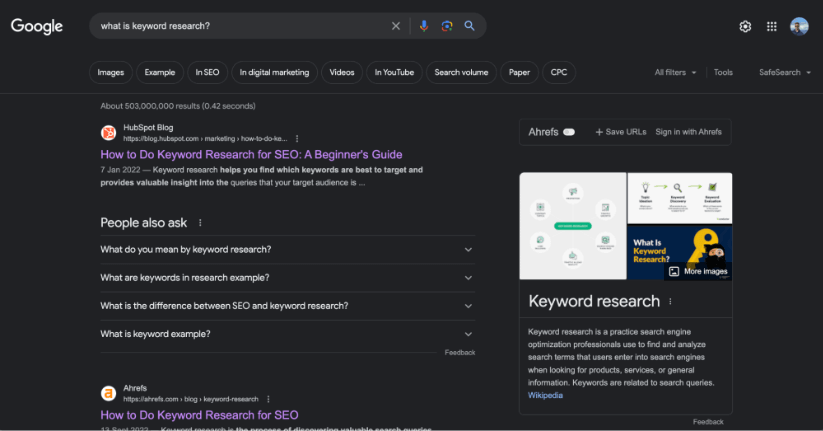
Understanding Keyword Research
The first step is to understand keyword research. We’ll now talk about keyword research and why it’s important for SEO. We will also discuss the impact of keyword research on different SEO-based tasks and include insights on how keyword research is effectively the market research of the digital age.
What is keyword research?
Keyword research is an essential process within SEO that involves identifying popular words and phrases (queries) that people enter into search engines intending to find a business like yours.
This practice enables marketers, content creators, and anyone involved in search marketing to understand the demand for certain terms and topics relevant to their target market. By analysing these keywords, marketers and others can craft ‘proper’ SEO strategies to improve their content’s visibility in search results, target their marketing efforts more effectively, and align their content with their audience’s needs.
Keyword research helps anticipate shifts in demand, respond to changing market conditions and produce the content, products and services your audience is actively seeking.
What impact does keyword research have on SEO-based tasks?
Keyword research significantly impacts SEO-based tasks as it guides the optimisation of website content to meet targeted audiences’ needs effectively. It enables SEO professionals and other marketers to understand what users are searching for, their language, and the type of content they prefer.
This understanding informs content creation, ensuring it is relevant, valuable and likely to rank higher in the SERPs.
Moreover, keyword research helps structure websites, optimise metadata, and create targeted marketing campaigns. Aligning a website’s content with the most relevant and searched-for keywords and queries increases the likelihood of attracting organic traffic, improves click-through rates, and enhances user engagement. All of these are crucial factors in boosting a website’s search rankings.
How is keyword research the ‘market research’ of the digital age?
Keyword research is, effectively, the market research of the digital age. I will stand by this statement as long as I work in SEO and digital marketing.
The practice of keyword research serves as a critical tool for understanding and tapping into the interests of an online audience. Beyond that, it also taps into the needs and behaviours of your audience, much like traditional market research does in offline contexts. In the digital landscape, where search engines are absolutely the primary gateway through which people access information, keyword research provides invaluable insights into what your audience is actively seeking.
Moreover, keyword research goes beyond the mere identification of popular queries. It delves into the nuances of language, intent, and context. It’s much the same as having a real-time focus group with a global reach, providing data on what people are interested in at any moment. This insight allows a business (and its content creators) to tailor its offerings and content strategies to precisely meet market demands, like how market research informs offline product development and marketing strategies.
Additionally, the data-driven nature of keyword research aligns well with the increasingly analytical approach of modern market research. It gives you quantifiable metrics like search volume and competition levels, enabling a more objective look into market opportunities and risks. In the digital age where data is king, keyword research is an indispensable component of any SEO strategy, serving a role similar to that of traditional market research but adapted to the online environment’s unique dynamics.
The Evolution of Keyword Research
Before we get into the ‘meat’ of the article and give you a repeatable process for doing amazing keyword research, we first need to ensure you understand how keyword research has evolved over the years.
We’ll talk about how it’s evolved, the shift from short-tail keywords to long-tail keywords, we’ll briefly talk about keyword clusters, and finally, we must talk about how the emergence of AI has impacted keyword research, too!
How has keyword research evolved over the years?
Keyword research has undergone a massive transformation over the years, mirroring the changes we have seen in search engines and user behaviour in the digital world.
Initially, keyword research was an incredibly straightforward process, primarily focussed on finding popular, often single-word or short phrases, known as short-tail keywords. Websites would incorporate these keywords to optimise their visibility in the SERPs. However, this approach often led to keyword stuffing, impacting content quality and, more importantly, user experience.
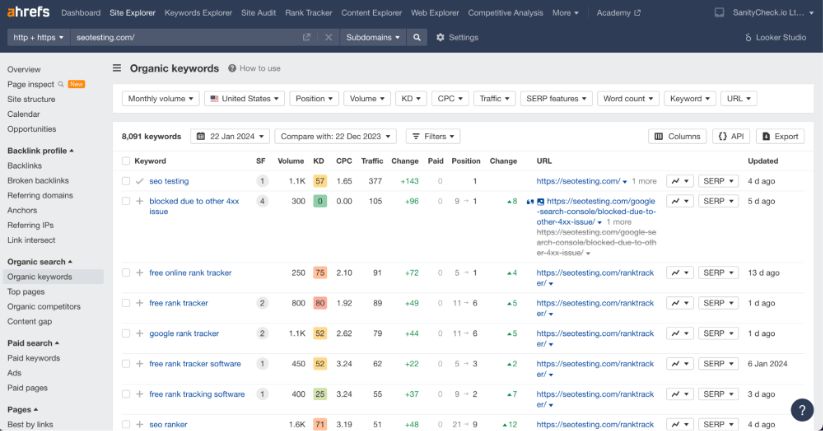
Think back to 2005. If you were writing an article targeting “SEO tools” as your main keyword, you would ensure this keyword was placed strategically, in many places, within your article’s content. Fortunately or unfortunately, it is not the case now.
What about the shift from short-tail to long-tail keywords?
As search engines, Google in particular, advanced, they began prioritising user experience and content relevance. This shift marked the full-time transition from short-tail to long-tail keywords.
What is a long-tail keyword? A long-tail keyword is a more specific, often longer phrase that is less competitive in search but highly targeted.
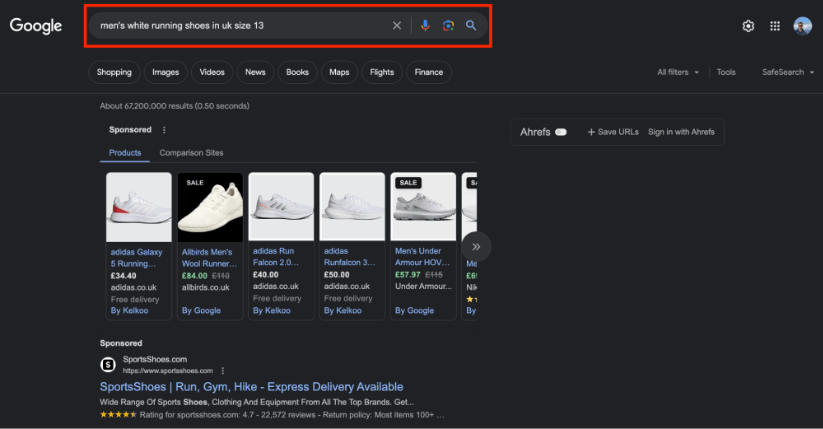
Long-tail keywords catered to a more refined understanding of user intent, acknowledging that users often search in full questions or detailed phrases when seeking specific information. This focus on user intent brought a more nuanced approach to keyword research, emphasising the need to understand the ‘why’ behind a search.
Alongside the shift towards long-tail keywords and optimising for user intent, we have seen a meteoric rise in the concept of semantic search. Semantic search refers to a search engine’s ability to understand the context and intent behind a search query rather than just the literal words used. This evolution led to the importance of keyword clusters for a piece of content rather than just a singular keyword. By targeting clusters, websites could address a broader range of user queries within a particular subject area, enhancing their authority and relevance in search engines.
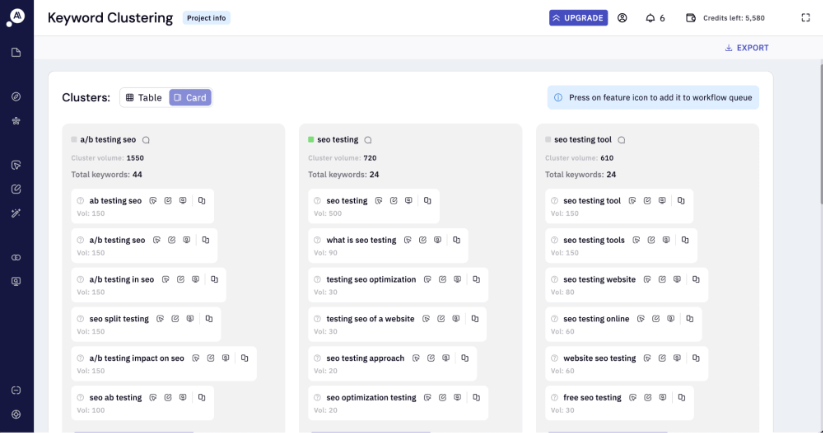
The above are examples of keyword clusters, taken from Keyword Insights.
Keyword Insights has a wonderful guide on keyword clusters!
How has AI (Artificial Intelligence) impacted keyword research?
The most significant leap in recent years has been the integration of AI and machine learning (ML) in keyword research and SEO more generally.
AI and ML algorithms have enabled us, as SEOs, to be more sophisticated in analysing search patterns and user behaviour, allowing for predictive analytics and more personalised search experiences. These technologies can analyse massive datasets to identify emerging trends, understand nuanced user intents, and predict which keyword might gain prominence.
This level of analysis not only refines keyword research strategies but also helps optimise content for future search trends, making SEO a more proactive (rather than reactive) field.
You can find the list of the top AI tools for SEO on our blog.

Step-by-Step Guide to Effective Keyword Research
We will give you a complete, step-by-step guide on conducting keyword research, giving you the best chance of dominating the search results in 2025 and beyond.
For each point, we’ve given you the basic step and written an example to help you understand it further. We’ve treated all the examples as if you are running an ecommerce store selling eco-friendly products, but these are repeatable for almost every business type.
Step 1: Define your goals
Before doing any keyword research, you need to clearly define what you want to achieve with both your SEO and content strategies! Whether it’s increasing traffic, generating leads, boosting sales, or improving brand awareness, your goals will guide the direction of your keyword research methodology.
For example, if you’re the SEO manager for an ecommerce site selling eco-friendly products, you may find that one of your goals is to increase online sales by 30% over the next quarter. This goal will direct your keyword research towards transactional and product-specific keywords likely to convert quickly into customers.
Step 2: Understand your audience
You need to gain a deep understanding of your target audience. What are their needs? What are their interests? What questions do they need answering? What are their specific pain points? Gathering these insights will help you predict the types of queries they might search for, enabling you to tailor your keyword research (and, therefore, your content) to their specific needs as a customer or potential customer.
For example, suppose your target audience is environmentally conscious, aged between 25 and 40. In that case, they are likely to search for terms like “biodegradable products,” “eco-friendly washing up liquid,” or “sustainable lifestyle tips.” Understanding this will help you tailor your keyword research to their specific interests.
Step 3: Generate some initial keyword ideas
Start by brainstorming potential keywords relevant to your products, services, or content topics. Consider the phrases your target audience might use in their search queries. You can use tools like Google Keyword Planner, Ahrefs, and Semrush to help if necessary. Remember that understanding your audience, as mentioned in the step above, will help you predict what they might search for.
For your eco-friendly ecommerce store, for example, your initial keyword ideas might include:
- Eco-friendly products
- Sustainable living
- Green cleaning supplies
These provide a starting point for more detailed research.
Step 4: Analyse the search intent of your initial ideas
For each keyword you have come up with in your initial brainstorm, analyse the intent behind that keyword. Is the user simply looking for more information? Are they trying to make a purchase? Or are they just looking to navigate to a particular website? Understanding search intent is crucial for ensuring that your content aligns with what users are looking (and searching) for.

If you realise people are searching for “benefits of using eco-friendly products” then it is likely that they are seeking information. You can target this keyword with informative blog posts rather than product pages and may find you more successful.
Step 5: Explore long-tail keywords
Now the above has been done, it’s time to focus on some long-tail keywords. These are less competitive but more specific. Sure, they might have lower search volumes, but they often have a much higher conversion rate as they target specific user needs! Again, tools like Ahrefs and Semrush can help with this. Another great tool to use is AlsoAsked!
Suppose you are an ecommerce business selling eco-friendly products. In that case, you might want to consider targeting “affordable eco-friendly home cleaning products” rather than “eco-friendly products” when starting to ensure you get some momentum quickly. You can consider targeting these big-head keywords as your business grows and your budget increases.
Step 6: Leverage keywords that your competitors are using
It’s time to analyse your competitors’ keywords to see which keywords they are actively targeting. You can use tools like Ahrefs and Semrush to search their site and find where they rank for particular keywords, which will help you understand which ones they are targeting and which are not. This can help you identify gaps in your strategy and find new keyword opportunities you might not have considered.
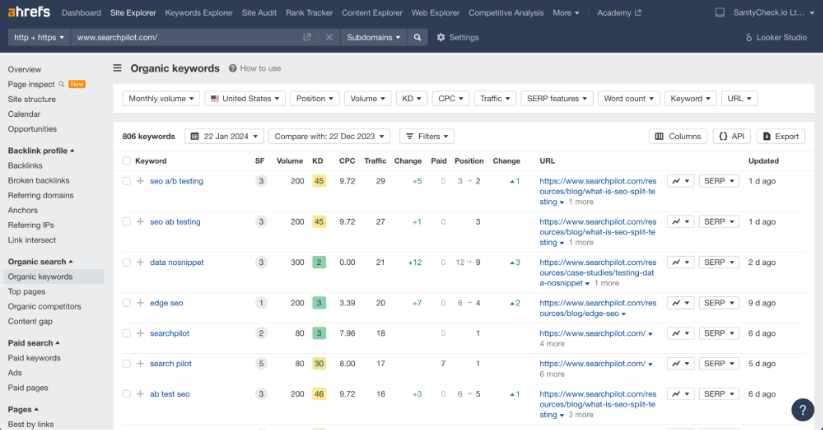
You can use Ahrefs to find the keywords your competitors are targeting!
If your competitor ranks highly for “organic eco-friendly bedding” and offers similar products, you should consider targeting this keyword to try and capture part of their traffic.
Step 7: Use keyword clusters
Instead of focusing on individual keywords, in 2025, it’s crucial to organise your keywords into topic clusters. This involves creating a document of all the keywords (short and long-tail) for which search engines provide the same result. This will help you be much more efficient with your budget for content creation. You can do this yourself, but using a tool like Keyword Insights will be much quicker and provide positive ROI.
Let’s say that you have decided that you wish to target “eco-friendly living ideas” for a blog post to write; putting this into Keyword Insights (for example) will spit out all of the different keywords that search engines like Google also show the same results for. You can add these other keywords to your content piece and gather more traffic with less effort.
Read the keyword clustering tools article to discover the best tools for this purpose.
Step 8: Rank and prioritise keywords
Not all keywords are valued as equally as others. You need to prioritise keywords based on factors like:
- Search volume
- Keyword difficulty
- Relevance to your business
- Alignment with user intent
This will help you focus on the most impactful keywords.
During this process, you may decide that you are going to prioritise “biodegradable kitchen sponges” over “eco-friendly” sponges if the former has a higher search volume but a lower competition metric. Doing this for all of your keywords gives you a great, prioritised lists of keywords to target sooner than others.
Step 9: Integrate keywords (and clusters) into your content strategy
Incorporate your final list of chosen keywords and clusters into your existing content. Ensure your content is optimised for search engines and provides real value to your audience.
This is crucial. If your content is not valuable to your user, it is not valuable to a search engine! You can do this via content refreshes over time.
When it comes to creating new content, your keyword list and list of clusters will determine your content plan going forward, so ensure you create a content plan that ensures that you write relevant pieces of content for each keyword and keyword cluster you deem valuable.
If you’re creating a blog post entitled “10 Best Eco-Friendly Kitchen Products for 2025” then, naturally, you may find that incorporating other keywords like “biodegradable kitchen sponges” and “sustainable kitchen tools” also brings in traffic too.
Step 10: Monitor and adapt over time
Naturally, keyword trends can change over time. Ensure you regularly monitor your keywords’ performance and adapt your strategy accordingly. You can use analytics tools to track your rankings, traffic, and engagement metrics, and refine your keyword strategy based on these insights.
If you find, over time, that “eco-friendly office supplies” as a keyword drives more traffic than you expected, then you might create more content around this sub-topic and explore related long-tail keywords to bring even more relevant traffic into the business through their website.
Analysing and Applying Keyword Data
Analysing and applying keyword data is a massively important process in SEO, involving an assessment of keyword competitiveness, search volume, and potential ROI! This analysis helps you to prioritise keywords and refine strategies over time to align with your business’s goals and SEO objectives.
Analysing keyword competitiveness and search volume
Keyword competitiveness refers to how difficult it is to rank for a specific keyword. Tools like Ahrefs, Semrush, and Moz can provide a ‘competitiveness’ score often called “keyword difficulty.” Generally, a higher score will indicate that the keyword has more competition. When analysing competitiveness, also consider the authority levels of other websites currently ranking for the keyword. If these are well-established sites, ranking for that keyword may be more challenging than ranking for another, longer-tail keyword.
Search volume, on the other hand, indicates how many times a query is searched for in a given period, generally a month. Whilst high search volume keywords can be attractive, it almost always come with higher competition. Something to keep in mind.
Please also remember to take these metrics with a pinch of salt, as they are never exact measurements. Even when they come from Google themselves.
Prioritising keywords based on business goals
When you are in the process of prioritising keywords, consider how they align with the goals of your business as well as your SEO targets. For example, if the goal is brand awareness, then you might prioritise high-search volume keywords to generate as much exposure as possible. However, if your goal is to increase sales and revenue, more specific, lower-volume keywords with a high intent to purchase will be more effective.
Tracking and refining keyword strategy
Ensure you are continuously monitoring the performance of your chosen keywords using tools like Google Analytics and Google Search Console. Tracking metrics such as rankings, click-through rates, overall search traffic, and conversions. This data will help you understand which keywords are performing well and which aren’t.
It’s important to regularly refine your keyword strategy based on performance data. SEO is not a set-and-forget thing. It requires ongoing adjustment and optimisation. Be prepared to:
- Add new trending keywords to your content plan
- Phase out underperforming keywords
- Adjust content to align better with high-performing keywords
Wrapping Things Up
In conclusion, mastering keyword research in 2025 and beyond is about much more than just identifying popular search terms. It involves a sophisticated blend of understanding audience needs, analysing search intent, and leveraging technological advancements like AI.
This comprehensive approach integrates these insights into a dynamic SEO strategy. As we’ve explored in this guide, from the evolution of keyword research to the step-by-step process of conducting it effectively, success in SEO requires an informed and adaptable approach.
Keyword research, in its modern form, is not just about traditional optimization; it’s about connecting with your audience in the most relevant and meaningful way. By staying adaptable, continuously monitoring trends and performance, and prioritizing the user experience, businesses and marketers can achieve a dominant presence in the ever-evolving landscape of search engine optimization.
Are you looking for a tool to help take your content strategy to the next level? SEOTesting is the tool for you. We integrate directly into Google Search Console so all the data is direct from Google. We then take this data and put it into helpful reports so you can make data-driven decisions quickly! Not to mention our fantastic range of SEO tests that you can conduct with the tool, from single-page tests to a/b split tests. We’re currently running a 14-day free trial with no credit card required to sign up, so give us a try today.


